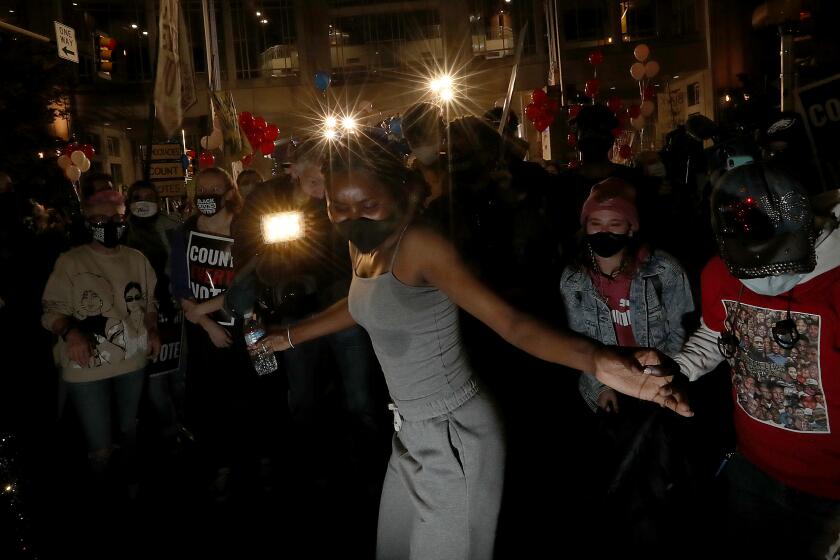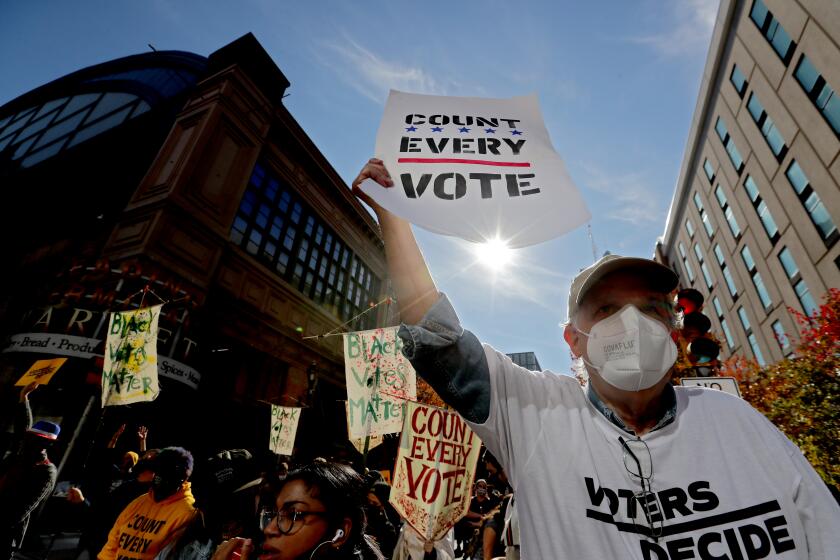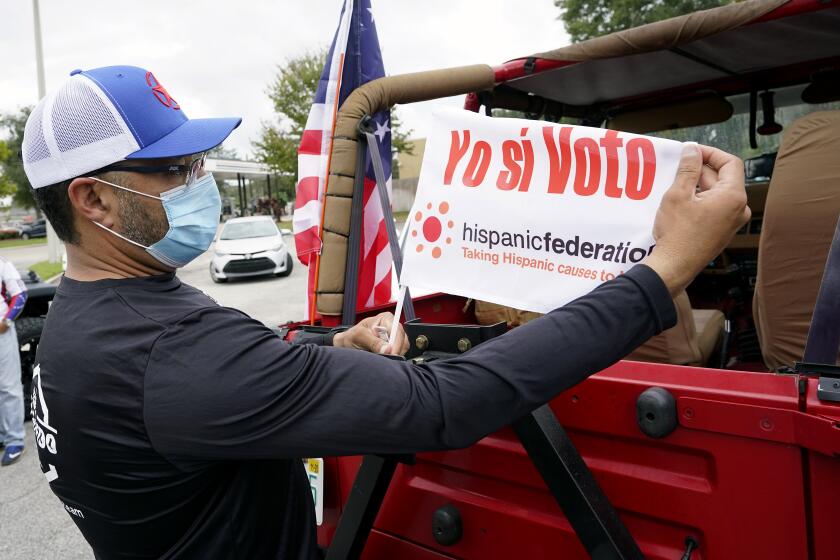Polls underestimated Trump’s support, but not by as much as you might think

- Share via
WASHINGTON — As returns from quick-counting states like Florida and Texas flowed in Tuesday night, pollsters quickly became targets in America’s easily triggered political culture.
With Democratic challenger Joe Biden running well behind poll-created expectations in those states, accusations of “collapse” and “disaster” peppered the nation’s pollsters. President Trump added to the fusillade Thursday by accusing them of deliberately releasing false results to discourage his supporters from voting.
But as states have counted more results, the picture has shifted: Polls did underestimate Trump’s vote, but by a relatively small amount — less, for example, than they underestimated President Obama’s strength in 2012, when he ran for reelection.
Photos: Election day voting is over but the counting continues.
Biden leads the popular vote, which is what polls measure, by about 2.6 percentage points and seems on track to win by around 5 points once all ballots have been tabulated. The national polling averages on election eve showed him winning by 7 to 8 points. A difference of 3 to 4 points would be smaller than the average error over the last couple of decades.
Polling errors were distributed unevenly across the country, however. In some states — Colorado, Minnesota and Virginia, for example — polls hit close to the mark. Those three have among the highest shares of college graduates in their populations, pointing to a particular problem pollsters have faced in the Trump years: difficulty counting the blue-collar white voters who have been the president’s strongest supporters.
In other states with large populations of such Trump voters, the errors were bigger, and in some, “the size of the discrepancy cannot be attributable to chance. Something else is at play,” said Courtney Kennedy, director of survey research at the nonpartisan Pew Research Center.
Biden may clinch the presidency with just one more state, and Democrats are confident he’ll get there once tallies end in Nevada, Pennsylvania or Georgia.
“Polls that were way off either did not interview enough Trump voters or they did interview enough Trump supporters, but [the supporters] lied about their vote,” she said.
Research indicates that lying to pollsters is rare, but failing to reach enough Trump voters and get them to answer questions appears to be a continuing problem, Kennedy said.
The places where larger polling errors occurred — Florida, Texas, parts of the Midwest — are also where some of the most competitive congressional races took place. As a result, the polling problems, which affected private campaign polls as well as public surveys, proved troublesome especially for House Democrats.
Overly rosy polls for Democrats — and overly pessimistic ones on the Republican side — raised expectations that Democrats would carry districts where they ended up going down to defeat. That generated anger that spilled into public view Thursday during a tense conference call of Democratic lawmakers.
It’s a political cliche grounded in a frustratingly and repeatedly misunderstood reality.
Rep Cheri Bustos (D-Ill.), the head of the House Democrats’ campaign operation, faced tough comments from her peers and blamed poor polling for Democratic losses.
“Voters looked more like 2016 than projected,” she said.
That much appears true. Unlike the 2018 midterm elections, in which Democrats benefited from a wave of anti-Trump voting, this year a pro-Trump surge matched the opposition, as mobilization by both sides drove turnout to an unprecedented high of roughly 160 million.
That high level of voting created a challenge for pollsters, said Patrick Murray, director of the Monmouth University Polling Institute, a highly regarded nonpartisan polling operation.
“Polling is an imprecise science in part because only two-thirds of eligible voters show up” even in high-turnout races, Murray said. “We don’t know who we’re polling” — whether they’re truly likely voters or not.
In this presidential cycle, Monmouth reported a range of results in each state it polled based on high-turnout and low-turnout scenarios. Even though the turnout was extremely high, the low-turnout scenarios were closer to accurate, Murray said.
Although it’s too early to know for sure, the reason seems to be that the electorate ended up not only bigger than expected but also more Republican than polls’ turnout models had assumed, Murray said.
Democrats often think that if more people vote, it automatically helps their candidates, he said, but “that’s not true” in all places. “In the Midwest, it’s the opposite,” because many of the voters who show up only sporadically are white residents of rural areas.
Another problem may involve Trump’s polarizing nature.
The controversial call received pushback from the Trump campaign. Fox News is holding firm and could call Biden the winner of the White House on Thursday night.
Pollsters work to avoid language on surveys that might cause people who hold unpopular beliefs — or who think their beliefs are unpopular — to balk at a question.
Avoiding that is hard when the controversial issue is the president himself, Murray said.
“He’s not just the president or a candidate,” he said. People who feel strongly about Trump believe that their view of him “says something about who they are,” and “that could play a role” in their willingness to answer questions.
Indeed, an experimental question that researchers asked on the USC Dornsife poll this year points in that direction.
The poll’s main question, which asked people the probability that they would support Trump or Biden, ended up projecting Biden would win the popular vote by nearly 11 points — a significant miss.
The experimental question asked people to estimate how others in their social circle would vote. It ended up showing Biden ahead in the popular vote by 4.1 points, very close to the likely final tally.
With the election in overtime, President Trump is pushing a mixed message, suing to stop the count in some states and urging others to keep counting.
“The idea behind the question is that people have a relatively good sense … of the political views of their friends and family,” said Wändi Bruine de Bruin, a professor of public policy at USC who has been studying the social-circle question.
“If there’s a candidate who people don’t feel comfortable saying they support, they might be more willing to say what their social circle will do,” she said.
The question proved accurate in 2016 and 2018 and has also been used successfully in several recent European elections, she said.
After 2016, when surveys underestimated Trump’s vote, pollsters took steps to try to more accurately measure the voters they had missed. In the 2018 midterms, polls were extremely accurate.
That reassured pollsters, but now that the problem has recurred, “it’s not clear if the fixes actually fixed anything,” said Vanderbilt University political scientist John Sides.
But, Sides added, much of the commentary about polling greatly exaggerates its problems. Research has found no evidence that polling errors have gotten worse over the last three decades; some evidence suggests polls have gotten more accurate.
And whatever the drawbacks of polling, “people are always going to want to know who is going to win the next election,” Sides said. “There’s never going to be a decline in the appetite for that.” If not polls, “what’s the preferred alternative?”
The public may need to “better calibrate” expectations about what polling can deliver, he added.
“If you start your postmortem with the expectation that a 3-point error is normal, that’s helpful,” he said. “You should never start with the assumption of zero.”
More to Read
Get the L.A. Times Politics newsletter
Deeply reported insights into legislation, politics and policy from Sacramento, Washington and beyond. In your inbox twice per week.
You may occasionally receive promotional content from the Los Angeles Times.
















